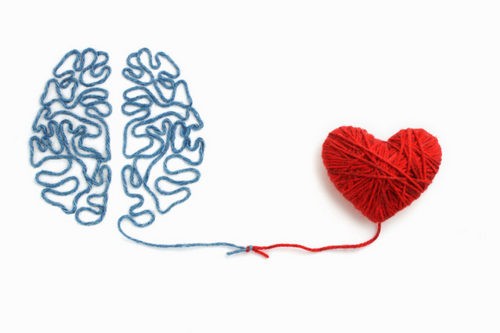Psychosomatic diseases are a group of diseases that are manifested by bodily suffering (that is, symptoms of diseases of internal organs), but their main reason nevertheless lies in malfunctions on the part of the nervous system.
These include a whole range of gastrointestinal upsets (functional gastric dyspepsia and irritable bowel syndrome), fibromyalgia (a specific pain syndrome in the projection of the joints), hyperventilation syndrome (a feeling of lack of oxygen and the need for frequent breathing) and much more.
In the 80–90s of the last century, a very famous psychologist, Professor Yu. M. Orlov, worked in our institute (First Sechenov Moscow State Medical University. – Ed. ). He owned the theory of “sanogenic thinking.” Its meaning boiled down to the fact that if you think correctly, cultivate good emotions and fight bad ones, you can prevent many diseases. I must admit that for the fragile minds of young doctors, his theory looked very convincing…
Can emotions affect health? Definitely yes. Being a cause is not. Negative emotions activate the sympathetic nervous system, which, in turn, leads to an increase in blood pressure, an increase in heart rate and vasospasm. Everyone knows stories when, for example, in fear or anger, people had heart attacks and strokes. I repeat: emotion in this case is not the cause of the disease, but only a provoking factor, a trigger.
In some cases, negative emotion, of course, can become the cause of the disease. For example, if you anger punch the wall, you can break your arm. Here you have a very clear causal relationship. By the way, one should not forget about the existence of an inverse relationship. Often the cause of negative emotions is chronic bodily suffering. Remember the Baba Yaga with a bone leg – perhaps she would be a very nice old woman, if not for chronic pain in the hip joint…

“All diseases from nerves” is a myth?
It’s not even a myth, it’s just an old student joke. The full quote is: “ All diseases are from nerves, and only five are from love ” (five classic sexually transmitted diseases are meant). However, chronic stress is a truly proven risk factor for developing at least cardiovascular diseases. Several years ago, using positron emission tomography (a high-precision study to study metabolic processes in various tissues), scientists identified mechanisms that transform stress into chronic inflammation, which, in turn, serves as a key mechanism for the development of atherosclerosis.
“However, I repeat again and again: stress is not the cause of disease, but one of the risk factors that works only together with other factors, primarily genetic.
Psychosomatic disorders: what are the causes and mechanisms of their occurrence?
I will explain how psychic suffering and somatic symptoms are related, as an example of the most common complaint with which a patient comes to a cardiologist – feelings of a rapid heartbeat. Tachycardia (frequent pulse) normally occurs when it is necessary to respond to an external stimulus, for example, to escape from danger. In this situation, the muscles need more blood, therefore, the heart should increase the frequency of contractions. But when the danger passes, the pulse returns to normal. A patient with a neurotic disorder is apparently calm, no one is chasing him, he does not need to catch up with anyone, but the brain gives a signal: “You are in danger, run away!” As a result, the sympathetic nervous system is activated, the pressure rises and the pulse quickens.

As for children’s psychosomatics, I’ll tell you another story. Recently, a young woman came to the reception. She looked very alarmed and kept trying to question me about her husband’s health, although, according to my ideas, her husband could well have come to the reception himself. In the conversation it turned out that the husband (a lot of working and well-earned people) at home constantly yelling at his wife and child, while still successfully manipulating his high blood pressure, but did not want to be treated. At the end of our meeting, the woman asked if I had in my mind a good neurologist, a specialist in children’s ticks… Should I continue the story? In my opinion, one does not have to be Dr. House to understand a simple thing: most transient neurological and neurotic symptoms in children are a problem for parents.

What is the “Chicago Seven” and how relevant is this classification today?
I do not really need to classify psychosomatic disorders in everyday work, and I first learned about the “Chicago Seven” thanks to this issue. I read and was horrified. Really, in the 21st century, someone can seriously consider them as “diseases of unreacted emotions”!
I will list these seven diseases with an indication of their true causes:
- Arterial hypertension is a disease based on a genetic predisposition, implemented by a dozen additional factors (smoking, overweight, salt abuse, lack of exercise, increased sugar and cholesterol, and so on). Stress is only one of the risk factors, but far from the main one.
- Peptic ulcer of the stomach and duodenum is a disease, the cause of which was well studied at the end of the 20th century. It is a microorganism called Helicobacter pylori. Yes, acute “stress” ulcers are described, but this is a completely different story.
- Inflammatory bowel disease (ulcerative colitis and Crohn’s disease) is a group of inflammatory autoimmune diseases with a genetic predisposition.
- Neurodermatitis (atopic dermatitis) is a disease with a genetic predisposition. Stress factor only in some cases can cause exacerbation.
- Bronchial asthma is a chronic inflammatory disease with a clear genetic predisposition. Sometimes stress can exacerbate, and sometimes vice versa – stimulation of the sympathetic nervous system leads to the expansion of the bronchi.
- Thyrotoxicosis (hyperthyroidism) is a classic autoimmune disease, which is based on the production of antibodies to thyroid tissue. Here woeful psychologists generally confuse cause and effect. Thyrotoxicosis greatly changes the character of a person – he becomes tearful, short-tempered, nervous. After curing thyrotoxicosis, mental manifestations completely disappear.
- Rheumatoid arthritis is a disease with an unknown nature (the relationship of genetic and infectious factors is discussed). However, stress has nothing to do with it.
Is Parkinson’s disease due to the desire for control? Adenoids in children appear when they feel that their parents do not like them?
The above examples are the fruit of the indefatigable imagination of couch psychologists. Both diseases have much more understandable causative factors, although not fully understood. But psychosomatic diseases of the gastrointestinal tract (functional dyspepsia, irritable bowel syndrome) are really characteristic of people who are suspicious, anxious and insecure. In ancient times, there was even a saying: any neuropath is a colopath (colon – lat. “Large intestine”).
Is hypochondria also a psychosomatics?
Strictly speaking, “hypochondriacal disorder” is not psychosomatics, it is pure “psyche”, that is, a real anxious neurotic disorder in which the patient endlessly searches for somatic diseases and clings to the most harmless symptoms. My mail is full of letters from hypochondriacs, who, having discovered dozens of extrasystoles (extraordinary contractions of the heart), immediately wonder what they now have the likelihood of sudden death.

How is the diagnosis of psychosomatic disorders?
Patients with psychosomatic disorders can visit doctors of any specialty. In some, the diseases are manifested by unmotivated shortness of breath and palpitations, in others by nausea, vomiting and diarrhea, and in some by pain syndromes.
The basis of diagnosis is a conversation with the patient. Only on the basis of how the patient makes complaints can one think about the presence of psychosomatic disorders. If the doctor has enough time to clarify the circumstances associated with the onset or exacerbation of the disease, if he finds neat words to clarify the traumatic situations, then the picture of the disease will begin to emerge. As I said, the dissociation between complaints and the lack of organic pathology is an important argument in favor of “psychosomatics”. Of course, a reasonable amount of additional examination is always necessary, but it should not be excessive.
Let me give you an example of one of the classic psychosomatic diseases – irritable bowel syndrome (IBS). In Russia, it is believed that a colonoscopy must be done to establish a diagnosis – a difficult and expensive endoscopic examination of the large intestine. All over the world they think differently. If long-term symptoms of intestinal discomfort (diarrhea or constipation, bloating, etc.) are not accompanied by the presence of so-called “red flags” (weight loss, blood in the stool, inflammatory changes in blood tests, late onset of the disease and the presence of cancer in close relatives ), then torturing the patient with such a difficult procedure as colonoscopy does not make sense – the diagnosis of IBS is very likely.
How many years have passed from the treatment of a patient with a psychosomatic disorder to the correct diagnosis? It’s not always the same. It seems to me that if you build communication with the patient correctly, then this is not at all difficult. But we are well trained. The fact is that our late teacher, former director of the faculty therapy clinic of First Honey (now Sechenov University), Professor V.I. Makolkin paid great attention to the study of psychosomatic pathology, as a result of which a small psychosomatic center was actually created on the basis of the clinic. The clinic staff are pretty well oriented in this kind of pathology, in addition, we are supported by a team of several psychiatrists.
It sometimes happens that years pass from the onset of the disease to professional assistance. It’s hard to say what this is connected with. Most likely, with the fact that colleagues “do not see” psychosomatics or are embarrassed to send patients to a psychiatrist, fearing that patients will misunderstand them.
How to treat psychosomatics?
It all depends on the situation; the concept of “psychosomatic disorders” is too broad. In mild cases, specific treatment is generally not required, a sufficiently detailed conversation between the doctor and the patient and an explanation of what is happening. The fact is that sometimes the patient is worried not so much by the symptoms themselves as by the unknown and suspicion of serious organic diseases. If we explain that behind the “sensation of incomplete inspiration” or “tingling in the heart” are not organic diseases of the heart and lungs, this will satisfy many patients.
In some cases, the internist (therapist, cardiologist, gastroenterologist and others) can independently prescribe psychotropic therapy, if he knows, of course, how to do it. For example, a qualified gastroenterologist can and should prescribe antidepressants for patients with functional diseases of the gastrointestinal tract without resorting to the help of psychiatrists. Why do antidepressants to gastroenterological patients? They are needed in order to break the pathological connection between the signals in the brain and the symptoms of the gastrointestinal tract. By the way, antidepressants have long ceased to be specific drugs for the treatment of depression. They are also successfully used in the treatment of certain pain syndromes.

If the internist feels that the patient needs serious combination therapy, then it is better to include a psychiatrist in the treatment, since psychopharmacology is quite complicated and the arsenal of drugs is diverse. It is advisable to consult not just with the psychiatrist from the district dispensary, but with a specialist who has experience working with psychosomatic patients.
Psychotherapy (that is, treatment in the colloquial genre) can be very useful for many patients with psychosomatic disorders. There are only two drawbacks: it is expensive and long. A contraindication to psychotherapy is the symptoms of a “big” mental illness (delusional disorders, hallucinations), however, this already goes beyond the scope of the topic “psychosomatics”.
But what the patient definitely does not need is the appearance of treatment using dummies: vitamins, “fortifying”, “metabolic”, “vascular” drugs, and so on.
Can psychosomatic diseases eventually transform into somatic pathologies?
Unlikely. Let’s go back to the beginning. They may be risk factors, but not the cause. That is, hyperventilation syndrome will not turn into asthma, IBS will not become ulcerative colitis, fibromyalgia does not transform into rheumatoid arthritis. It is only important to understand that with age, the risk of real somatic diseases increases. It is only necessary not to miss their beginning.
What is mental hygiene and how can it help?
Perhaps, hygiene can be a way to prevent such disorders, although it is not so simple. Here again, it is appropriate to recall the theory of “sanogenic thinking” by Yu. M. Orlov.
From myself I will add four positions that I try to follow myself:
- limit negative information flow. Do not let the TV run in the background. Better include music or your favorite movies in your recordings;
- Separate work from home. Get two phone numbers – for home and office calls, turn off the work mobile phone at home, on weekends and on vacation;
- remember the most difficult event in your life. Maybe everything else is not worth it to go crazy?
- The best way to get rid of accumulated fatigue and irritation is through physical activity.
And the last one. If you feel that something in life is going completely wrong and you cannot get out on your own, do not hesitate to contact specialists in the field of psychiatry and psychotherapy. Modern psychiatry has gone far ahead compared to the classic view of it in the film “Flight over the Cuckoo’s Nest”.



